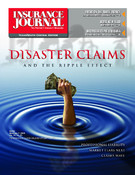In the wake of Hurricanes Katrina and Rita, we have an historic opportunity to make crucial changes to Louisiana’s building codes and construction practices. Doing so will help create more resilient homes, businesses and communities for Louisianans when future hurricanes strike. Fortunately, it appears this issue will be a major priority for the upcoming special legislative session.
Louisianans’ insurability of homes, quality of life, personal safety and economic viability all depend on personal, commercial and public property being better able to withstand future storms. It would compound the current disaster if this opportunity to focus on adopting a uniform, significantly upgraded building code is squandered.
Over the past five years, the number of states with statewide model building codes has increased from 21 to 32. Florida has emerged as the model, and enhanced building codes adopted after Hurricane Andrew hit in 1992 have more than proven their worth.
The evidence was crystal clear last year. Hurricane Charley-a very intense, Category 4 Katrina-like storm-provided a true test of the new building codes. One only had to compare homes in the same vicinity, one built to pre-updated standards, the other constructed after the Florida Building Code went into effect in 2001, to see the dramatic difference building codes can make. Newer structures that were built properly and inspected fared much better than pre-building code structures.
A recent study by Applied Insurance Research-Worldwide found that insured losses in 2000 would have been reduced by approximately 40 percent following a storm similar to Hurricane Andrew if all structures were constructed in accordance with the current Florida Building Code. This assumes 100 percent enforcement and that the code applies to all buildings, both new and existing. This difference in total probable losses is due to an impact on personal property losses-clothing, furniture, televisions, photo albums, etc.-as well as structural losses, illustrating what a dramatic effect building codes have on the extent of content losses, too.
During a recent Louisiana Uniform Building Code Task Force meeting, the Institute for Business and Home Safety presented a Post-Katrina Huricane Resistant Reconstruction Plan designed to “rebuild lives and reduce future structural damage through improved building safety and design by addressing the minimum standards of wind and flood resistant construction, compliance, construction management and design.” While implementing more stringent, uniform building codes will not alleviate all potential wind and flood damage, the threat from higher wind speeds and flood levels can be significantly reduced.
Additional flood mitigation efforts also should be considered, such as:
• Updated flood hazard mapping and strict enforcement of local, state, and federal flood insurance requirements for flood plain management.
• Elevating homes or businesses in flood or storm surge areas. Proper elevation above anticipated 100-year flood plains makes federal flood insurance more available and affordable. Combined with proper wind protections, elevated homes or businesses have a much better chance of surviving a hurricane with minor damage.
• Broader community participation in the national flood insurance and flood management programs.
While it is true that stronger building codes could increase reconstruction costs in the short term, such costs tend to be marginal-and the trade-offs are substantial. Following Katrina and Rita, homeowners and businesses will rebuild with a combination of private insurance, government insurance, and other direct disaster aid. When figuring out how best to spend recovery dollars, hurricane victims should focus on safety. Perhaps, for example, it is worth trading a glass-enclosed sunroom for a structure with all the proper hurricane clips and anchors to hold the building together, and/or wind borne debris resistant windows and doors.
Consumers can work toward rebuilding based on more storm-resistant standards even before a stringent building code is enacted. Once there is a real market demand for hurricane-related safety features, competition to meet consumer desire tends to drive costs down. Also, comprehensive uniform codes often help lower costs for builders in the long-term, allowing them to deal with one standard rather than a patchwork of regulations among jurisdictions.
President Bush noted in his Sept.15, 2005, public address to the nation that, “Clearly, communities will need to move decisively to change zoning laws and building codes in order to avoid a repeat of what we have seen.”
It is critical for Louisiana to move in a quick, yet thoughtful manner to rebuild and protect future generations of Louisianans in every part of the state.
Tiffany O’Shea is director of Public Affairs for the
American Insurance Association.
Topics Florida Catastrophe Louisiana Flood Hurricane
Was this article valuable?
Here are more articles you may enjoy.


 California Sees Two More Property Insurers Withdraw From Market
California Sees Two More Property Insurers Withdraw From Market  Investment Funds File New Suits Over Lighthouse Insurance Collapse in 2022
Investment Funds File New Suits Over Lighthouse Insurance Collapse in 2022  JPMorgan Client Who Lost $50 Million Fortune Faces Court Setback
JPMorgan Client Who Lost $50 Million Fortune Faces Court Setback  UnitedHealth Says Hackers Possibly Stole Large Number of Americans’ Data
UnitedHealth Says Hackers Possibly Stole Large Number of Americans’ Data 


